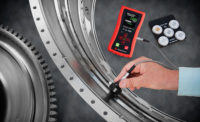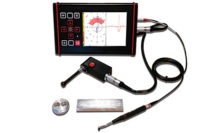
Information Model Hierarchy: This figure illustrates the hierarchy of information object definitions (IODs) with multiple information modules consisting of multiple attributes.
Industry standards play a pivotal role in the advancement of science and technology. Countless manufacturing standards have enabled large strides in the efficiency of producing everything from automobiles to aircraft engines. The information technology industry is just beginning to see the benefits of standardization. Data exchange standards such as hyper-text markup language (HTML), joint photographic experts group (JPEG) and the MPEG-1 Audio Layer 3 (MP3) have been the driving force behind the explosion of the Internet, digital photography and portable music players.
Just as data is the heart and soul of digital photography, data is equally important to nondestructive testing (NDT). Critical national and commercial infrastructure requires long-term data management solutions for inspection data. In the United States, nuclear power plants are typically licensed for 40 years, but can obtain an operating extension for an additional 20 years. Military and commercial aircraft lifespans are established based on takeoff and landing cycles and can last more than 20 years; many military aircraft are more than 30 years old. The age of the B-52 bomber and the KC-135 tanker that both the U.S. Air Force and U.S. Navy rely on to refuel other planes average more than 45 years old. Over such long time periods, inspection equipment is replaced with new models and equipment vendors may go out of business while the need to access the data acquired with the equipment remains. There is a need to promote interoperability as inspection equipment is modernized to provide long-term data access.
Inspection Data Storage
Historically, the NDT industry has relied on proprietary formats to store inspection data. With the volume of data collected increasing, due to the change from traditional data collection methods such as film in X-ray and paper charts in eddy current to digital storage, the need for a transparent and industry standard data format is increasing.There have been attempts to develop an NDT data exchange and storage standard in the past. In the early 1990s, the Trappist Project was part of the European Union’s RACE2 communication technology program and demonstrated a distributed 3-D NDT test system for remote data assessment. With 10 participant organizations representing end users and NDT institutes, this project was followed by a standardization project by the European Committee of Standardization (CEN) leading to a published technical report in 2000. Recently, papers have been published discussing the use of XML (extensible markup language, a data format widely used in information systems for sharing structured data) to make data exchange possible. None of these formats, however, has seen widespread adoption.
Dicom
In the 1980s, the medical field faced a similar problem as manufacturers of medical imaging devices supported proprietary communication and data exchange mechanisms found in the inspection equipment industry today. The digital imaging and communication in medicine (DICOM) committee started in 1983 as a joint effort between manufacturers and users of radiological imaging equipment to produce the ACR-NEMA 300-1985 publication. This publication was revised and called the DICOM standard version 3.0 in 1993. The latest version of the standard is still designated 3.0 although it has been updated and extended. Instead of using the version number, the standard is often referred to using the release year, as in “DICOM-2008.” Since 1993, DICOM has achieved a near universal level of acceptance among medical imaging equipment vendors and healthcare IT organizations, becoming the de facto standard in the medical industry.The DICOM standard is based on a detailed information model designed to promote reuse and extensibility. Near the top of the model hierarchy is the information object definition (IOD). The IOD is designed to encapsulate a real-world data set such as a digital X-ray image or ultrasound image. The IOD is defined in terms of information modules. Information modules hold organized groups of metadata about the image. This metadata extends beyond what is found in other image data formats such as TIFF or JPEG to include information about the patient, test method, test equipment and hospital.
Information modules in turn are composed of individual data elements called attributes. Example attributes range from patient name to transducer frequency to instrument serial number. Information modules and attributes that are similar across multiple imaging modalities are reused so that they are only defined once in the standard. Therefore, information modules may be used in more than one IOD, and attributes may appear in more than one information module.
Diconde
Based on the success of the DICOM standard, a group of experts in nondestructive testing began exploiting the similarities between medical imaging equipment and industrial inspection systems in the late 1990s. Working with ASTM International, they developed the digital imaging and communications in nondestructive evaluation (DICONDE) standard based on the DICOM standard. First published in 2004 as ASTM Standard Practice E2339, the standard has undergone a series of revisions to improve its usefulness to the industry, but it is still in its infancy.The approach of the ASTM E07.11 subcommittee on DICONDE has been to reuse DICOM IODs, information modules and attributes where possible. For example, the patient module has been redefined to be the component module.
Wherever possible, references to the DICOM standard are used to minimize repetitious information and the need to modify the ASTM standard every time a change takes place in the DICOM standard. The DICOM standard allows the ASTM team the flexibility to both ignore elements of the standard that do not apply to industrial imaging and to create new information modules and attributes where no reasonable medical equivalent exists. Examples of DICONDE information modules are component, component study and NDE equipment. Examples of attributes are component name, component ID and system serial number.
Future Plans
Since the publication of E2339 in 2004, the DICONDE team has been focused on receiving feedback from those implementing the standard and incorporating suggested changes. The current version, E2339-08, has been updated to allow wide-scale adoption of the standard. Early adoption has been largest in the area of digital radiographic testing where the similarities between medical and industrial imaging are most pronounced. In addition to radiography, DICONDE is being used for ultrasonic, computed tomography, thermography, visual and eddy current test methods.To address the needs of these different modalities, the DICONDE subcommittee is working on draft standard practices to support the data storage requirements of each of these modalities. The original DICONDE standard practice, E2339, will continue to exist and will specify data storage requirement that apply to all NDE modalities. Additional draft standard practices are in preparation to address the specific needs of individual NDT modalities. The subcommittee is also investigating methods for testing the interoperability of different products on the market following the DICONDE standard for data storage and communication.
With rapid changes driving the digitization of NDT methods, there is a clear need to develop an industry standard data exchange and storage method. To not do so would limit the value of that data for both engineering analysis and tracking a component’s performance during its service life. A group of industry experts has developed a standard for NDT data exchange and storage leveraging a highly successful standard from the medical industry and the open standards development process of ASTM International. ndt
Patrick Howard is chairperson of the ASTM International subcommittee on DICONDE. Lloyd Arrowood and John Hansen are leaders of the DICONDE task groups developing standard practices for radiography and eddy current respectively. To learn more about adopting the DICONDE standard or to participate in its continued development, e-mail the authors at [email protected], [email protected] and [email protected]. For more information, visit www.astm.org.

